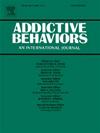目前使用酒精和烟草的成年人中同时使用和混合使用酒精、烟草和大麻的比率及其相关关系
IF 3.7
2区 医学
Q1 PSYCHOLOGY, CLINICAL
引用次数: 0
摘要
背景:目前很少有研究表明同时使用多种物质会造成负面健康后果的附加风险。我们研究了与同时使用相关的比率、社会人口和州大麻合法化状况(即使用>;在目前使用酒精和可燃烟草制品的美国成年人样本中,烟草、酒精和大麻的混合(例如,共同使用物质)。方法:通过一个调查小组,我们招募了1300名美国成年人,他们在2021年6月至7月期间报告了过去30天的酒精和可燃烟草使用情况。我们拟合逻辑回归模型来检验社会人口学特征和大麻合法化状况与使用酒精、烟草和大麻之间的关系。结果大多数参与者(67%)报告同时使用酒精和烟草。一半以上(55.5%)的烟酒共同使用者报告过去30天使用过大麻,42.1%报告同时使用烟草和大麻,45%报告以钝器的形式混合使用烟草和大麻。此外,36.5%的人报告同时使用酒精和大麻,33.1%的人报告同时使用酒精和钝器。年龄、种族、性别和收入水平与同时使用某些物质有关。各州大麻合法化状况与结果无显著关联。总的来说,在美国有目的的成年人样本中,同时使用酒精和烟草产品的患病率很高。研究人员应考虑在共同使用者的样本中测量物质的同时使用情况,这可能为以停止或减少物质使用危害为重点的干预措施的效果提供信息。本文章由计算机程序翻译,如有差异,请以英文原文为准。
Rates and correlates of simultaneous use and mixing of alcohol, tobacco, and cannabis among adults who currently use alcohol and tobacco
Background
Little research exists on simultaneous use of multiple substances that pose additive risk for negative health outcomes. We examine rates and sociodemographic and state cannabis legalization status correlates of simultaneous use (i.e., use > 1 substance on the same occasion) and mixing (e.g., co-administration of substances) of tobacco, alcohol, and cannabis among a U.S sample of adults who currently use alcohol and combustible tobacco products.
Methods
Using a survey panel, we recruited 1,300 U.S. adults who reported past 30-day use of alcohol and combustible tobacco between June to July 2021. We fit logistic regression models to examine associations between sociodemographic characteristics and cannabis legalization status with use of alcohol, tobacco, and cannabis.
Results
The majority (67%) of participants reported simultaneous alcohol and tobacco use. Over half (55.5%) of tobacco and alcohol co-users reported past 30-day cannabis use, 42.1% reported simultaneous tobacco and cannabis use, and 45% reported mixing tobacco and cannabis in the form of a blunt. Additionally, 36.5% reported simultaneous alcohol and cannabis use, and 33.1% reported simultaneous alcohol and blunt use. Age, race, gender, and income level were associated with simultaneous use of some substances. State cannabis legalization status was not significantly associated with outcomes.
Conclusions
Overall, the prevalence of simultaneous use was high among this U.S. purposive sample of adults who reported current co-use of alcohol and tobacco products. Researchers should consider measuring simultaneous use of substances in samples of co-users, which may inform the efficacy of interventions focused on cessation or harm reduction of substance use.
求助全文
通过发布文献求助,成功后即可免费获取论文全文。
去求助
来源期刊

Addictive behaviors
医学-药物滥用
CiteScore
8.40
自引率
4.50%
发文量
283
审稿时长
46 days
期刊介绍:
Addictive Behaviors is an international peer-reviewed journal publishing high quality human research on addictive behaviors and disorders since 1975. The journal accepts submissions of full-length papers and short communications on substance-related addictions such as the abuse of alcohol, drugs and nicotine, and behavioral addictions involving gambling and technology. We primarily publish behavioral and psychosocial research but our articles span the fields of psychology, sociology, psychiatry, epidemiology, social policy, medicine, pharmacology and neuroscience. While theoretical orientations are diverse, the emphasis of the journal is primarily empirical. That is, sound experimental design combined with valid, reliable assessment and evaluation procedures are a requisite for acceptance. However, innovative and empirically oriented case studies that might encourage new lines of inquiry are accepted as well. Studies that clearly contribute to current knowledge of etiology, prevention, social policy or treatment are given priority. Scholarly commentaries on topical issues, systematic reviews, and mini reviews are encouraged. We especially welcome multimedia papers that incorporate video or audio components to better display methodology or findings.
Studies can also be submitted to Addictive Behaviors? companion title, the open access journal Addictive Behaviors Reports, which has a particular interest in ''non-traditional'', innovative and empirically-oriented research such as negative/null data papers, replication studies, case reports on novel treatments, and cross-cultural research.
 求助内容:
求助内容: 应助结果提醒方式:
应助结果提醒方式:


